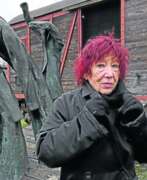Jewelers Contemporary art


Edgar Augustin was a German painter and sculptor.
Augustin studied sculpture in Münster with Karl Ehlers, then was a pupil of the master Gustav Zeitz in Hamburg. His oeuvre includes partly abstract figurative representations in bronze, wood and plaster as well as paintings, drawings and graphics. Some of Edgar Augustine's sculptures are located in public spaces in Hamburg and other cities.
Edgar Augustin was a member of the Free Academy of Arts in Hamburg and the Special Association of Artists in Germany. In the second half of the 20th century, Augustin was one of the pioneers of figurative wood sculpture and is considered its most important representative.


Pol Bury was a Belgian sculptor and artist, celebrated for integrating movement into his sculptures and pioneering the kinetic art movement. Born on April 26, 1922, Bury began as a painter in the Jeune Peintre Belge and the COBRA groups, later transitioning to sculpture. His most renowned work, the fountain-sculpture 'L'Octagon', is a highlight in San Francisco. His innovative art was acknowledged when his work was auctioned at Christie's in 2008, recognizing the unique nature of his contributions to art.
Pol Bury's creations can be found in permanent collections, like that of the Chelsea Art Museum, amongst others.
.


René Carcan was a Belgian painter, engraver, sculptor and jeweler.
He studied sculpture at the Academy of Saint-Josse-Ten-Nod and then painting at the Brussels Academy.
Carcan developed an artistic style that has been compared to Henri Matisse, and the frescoes of Tuscany and Etruria became one of his main sources of inspiration. Carcan was a prolific and polymorphous artist, always eager to experiment. In addition to his work in printmaking, he enjoyed sculpture and jewelry making.


Ettore (Ted) DeGrazia was an American Impressionist painter, sculptor, composer, actor, director, designer, architect, jeweller and lithographer.
DeGrazia is known for his colourful depictions of Native American children in the American Southwest and other western scenes. He has been called "the most replicated artist in the world."


Patrick Dupré is a French op-art and kinetic artist.
While working for the aluminum company Pechiney in Paris in 1964, he created his first work "Skyscraper" on aluminum plate using rubber, ink, sharpener, blade and Shabu knife, and in the 1970s he already developed his own technique of etching on aluminum foil. During the same years, Dupre also invented a new method of industrial engraving on silver, gold and metal bowls. He created art prints by hand, engravings on copperplate, gravure prints and etchings on drypoint. Since 2012, Dupre has produced Op-Art jewelry based on his work and lives in the French countryside.


Rei Kawakubo is a Japanese fashion designer based in Tokyo and Paris. She is the founder of Comme des Garçons and Dover Street Market. Although not formally trained as a fashion designer, Kawakubo did study fine arts and literature at Keio University. After graduation she worked in the advertising department at the textile company Asahi Kasei and she went on to work as a freelance stylist in 1967. Two years later, she began to design and make her own clothes under the label Comme des Garçons. In 1969, she established her own company, Comme des Garçons Co. Ltd in Tokyo and opened up her first boutique there in 1975. Starting out with women's clothes, Kawakubo added a men's line in 1978. Three years later, she started presenting her fashion lines in Paris. Comme des Garçons specialises in anti-fashion, austere, sometimes deconstructed garments. Kawakubo likes to have input in all the various aspects of her business, rather than just focusing on clothes and accessories. She is greatly involved in graphic design, advertising, and shop interiors believing that all these things are a part of one vision and are inextricably linked.


E. R. Nele or Eva Renée Nele Bode is a German sculptor that works goldsmithing and large scale metal sculptures.
Her best-known sculpture is named Die Rampe, a Holocaust memorial dated from 1980. Her latest metal sculpture at large scale is now located at the Dalbergplatz in Frankfurt-Höchst and named Windsbraut.


Peter Philippen (German: Peter Josef Maria Philippen) was a German painter and jeweler.
He studied at the School of Applied Arts in Pforzheim as a jeweler and then at the Düsseldorf Academy of Art. At first he worked as a jeweler, but since 1965 he increasingly turned to painting and experimented with paints of his own making, often with admixtures such as sand.

























































































